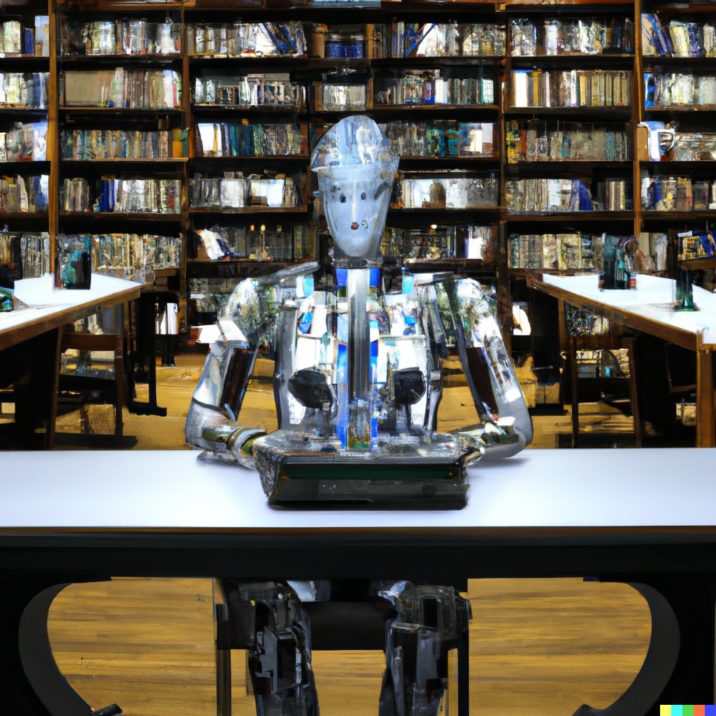Several faculty members in CMS/W have expertise, both technological and pedagogical, in what the use of ChatGPT and other A.I. tools may mean for the instruction of academic writing. Because instructors at MIT and elsewhere have expressed some urgency in better understanding what the effects and ethics of ChatGPT may be, two pairs of our faculty have provided an advisory memo and a response.
It should be noted that with tools like ChatGPT being both so new and so quickly evolving, these pieces are the faculty’s take and don’t yet represent official guidance from CMS/W or MIT.
First is an excerpt from “Advice Concerning the Increase in AI-Assisted Writing”, a memo from Edward Schiappa, Professor of Rhetoric, and Nick Montfort, Professor of Digital Media. The full document is available at Montfort’s website. (January 26 update: Professor Montfort discussed this topic with NPR’s All Things Considered.)
It may be that the use of a system like ChatGPT is not only acceptable to you but is integrated into the subject, and should be required. One of us taught a course dealing with digital media and writing last semester in which students were assigned to computer-generate a paper using such a freely-available LLM. Students were also assigned to reflect on their experience afterwards, briefly, in their own writing. The group discussed its process and insights in class, learning about the abilities and limitations of these models. The assignment also prompted students to think about human writing in new ways.
There are, however, reasons to question the practice of AI and LLM text generation in college writing courses.
First, if the use of such systems is not agreed upon and acknowledged, the practice is analogous to plagiarism. Students will be presenting writing as their own that they did not produce. To be sure, there are practices of ghost writing and of appropriation writing (including parody) which, despite their similarity to plagiarism, are considered acceptable in particular contexts. But in an educational context, when writing of this sort is not authorized or acknowledged, it does not advance learning goals and makes the evaluation of student achievement difficult or impossible.
Second, and relatedly, current AI and LLM technologies provide assistance that is opaque. Even a grammar checker will explain the grammatical principle that is being violated. A writing instructor should offer much better explanatory help to a student. But current AI systems just provide a continuation of a prompt.
Third, the Institute’s Communication Requirement was created (in part) in response to alumni reporting that writing and speaking skills were essential for their professional success, and that they did not feel their undergraduate education adequately prepared them to be effective communicators.[1] It may be, in the fullness of time, that learning how to use AI/LLM technologies to assist writing will be an important or even essential skill. But we are not at this juncture yet, and the core rhetorical skills involving in written and oral communication—invention, style, grammar, reasoning and argument construction, and research—are ones every MIT undergraduate still needs to learn.
And next is a response co-authored by Professor Eric Klopfer, head of CMS/W and Literature and director of the Scheller Teacher Education Program, and Associate Professor Justin Reich, director of the Teaching Systems Lab.
“Calculating the Future of Writing in the Face of AI”
When the AI text generation platform ChatGPT was released, it made a lot of people take notice of the potential impact of the coming wave of Large Language Models (and even proclaim the end of the college essay). The uproar over ChatGPT prompted mathematics educators to declare, “Ha, writing people, now it’s your turn!” Or, as math teacher Michael Pershan framed the issue, in an effort to capture the mood of ChatGPT headline writers, “I FED CASIO-FX1239x MY MATH TEST AND WAS ASTONISHED BY THE RESULTS.”
There now exists a computing device which, when given open-ended queries similar to those typically offered by instructors, responds instantly and automatically with a range of plausibly correct results. A reliance on this device could deprive students of the opportunities to develop for themselves the foundational skills necessary for the human resolution of said queries. Or it could usher in a new era of human inquiry and expression assisted by technology. Or both. The humble calculator has been the perfect rehearsal for the challenges we face today.
As calculators became cheap and ubiquitous, they threatened the teaching of rote mathematics (Per Urlaub and Eva Dessein draw a similar comparison to the related issue of automated language translation). At that inflection point, teachers typically pursued any of three choices: 1) they could allow calculators and risk trivializing existing learning experiences, 2) ban calculators in the hopes of preserving the pre-Casio status quo, or 3) adapt and create some learning environments where students could not use calculators (prominent today in the memorization of math facts like times tables) but in most places shift instruction to challenge students to think about what they need to enter into the calculators.
The first two tactics were largely unsuccessful, though they persist to some extent. Our challenge is to figure out where to preserve the best of older habits, while shifting to embrace new technologies for how, like calculators, they can augment human capacity in our disciplines.
Writing instructors already have much experience with these challenges. Spellcheck software was banned in many classrooms because of its potential negative effects on student spelling. Today, a student who didn’t spellcheck their paper is labeled as careless. Wikipedia, research sources on the internet, and automated translation services (for our colleagues teaching writing in second languages) have all bedeviled writing instructors in recent years.
We should be cautious about technological determinism; we should be cautious about the creeping belief that we simply have to accept and adapt to ChatGPT. Maybe ChatGPT is terrible in ways we don’t yet understand, and bans will prove to be a viable and important option. But the history of these recent aids to human cognitive and communication suggests that they are pretty helpful; the best of their contributions can be integrated into our writing practices, and the worst of their shortcuts can be mitigated by walling them off from targeted areas of our curriculum–by teaching bits and pieces here and there where ChatGPT and future tools are banned, like calculators are banned when students memorize math facts. If ChatGPT proves to be an outlier from this historical trend, by all means let’s ban it, but until then let’s proceed cautiously but open to possibilities. The proclamations of the end of the essay have come alongside both popular press such as in The New York Times and TIME and scholarly work (such as “New Modes of Learning Enabled by AI Chatbots: Three Methods and Assignments” by Ethan R. Mollick and Lilach Mollick) with a more hopeful outlook – one that both sees short term benefits and positive long term shifts.
In terms of practical advice for instructors who rely on written papers as a form of assessment, the most important advice is to try some of these tools out yourself to see what they can and cannot do. After doing so you may decide that as they stand now, you should prohibit their use entirely. But you might instead choose to limit use to certain cases that would need to be documented. For example, you might allow students to generate ideas for an initial draft but not allow any prose generated by the models. There are several ways in which these tools could be used right away:
- They can be used to help struggling writers who don’t know where to begin with their assignments.
- They can be used as a thought partner by students as they bounce around ideas that can be further developed.
- They can help students revise their ideas through reframing or restating their prose.
The presence of disruptive technologies like ChatGPT should cause us to reflect on our learning goals, outcomes, and assessments, and determine whether we should change them in response, wall off the technology, or change the technology itself to better support our intended outcomes. We should not let our existing approaches remain simply because this is the way we have always done them. We should also not ruin what is great about writing in the name of preventing cheating. We could make students hand-write papers in class and lose the opportunity to think creatively and edit for clarity. Instead, we should double down on our goal of making sure that students become effective written and oral communicators both here at MIT and beyond. For better or worse, these technologies are part of the future of our world. We need to teach our students if it is appropriate to use them, and, if so, how and when to work alongside them effectively.
In the 19th century, a group of secondary school educators believed urgently and fervently that sentence diagramming was an essential part of writing education. They fought tooth and nail in education journals, meetings, and curriculum materials to preserve their beloved practice. They were wrong. We’re fine without them. Maybe we will be fine without the short answer questions that call for the recounting of factual information, the sorts of homework questions where ChatGPT currently seems to do pretty well (though, just like our students, it sometimes makes up incorrect but plausible-sounding responses).
Assuredly, we will need to think deeply about the new affordances of ChatGPT, and the kinds of thinking and writing we want students to do in the age of AI and change our teaching and assessment to serve them better. We will have to have the kinds of conversations and negotiations with students that we had upon the arrival of Wikipedia, other Internet research sources, grammar and spell checkers, and other aids to research and writing. They took up a good bit of class time upon their arrival, and then we settled into more efficient and productive stances.
We will also need to think about whether these technologies cause us to define new outcomes and skills that we will need to find new ways to teach. At MIT, an institution which is at the forefront of AI and one that prides itself in both its teaching in the humanities and consideration of the human implications of technology, we should lead the way in studying and defining this path forward.
Ultimately, Michael Pershan from his math classroom sends us writing teachers his good wishes: “If the lives of math teachers — who have a head start on this calculator business — are any example, it’ll change things slightly and give everyone something fun to fight about.” We look forward to the ensuing debates.





